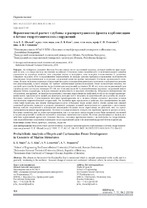Вероятностный расчет глубины и распространения фронта карбонизации в бетоне гидротехнических сооружений

Date
2018Publisher
Another Title
Probabilistic Analysis of Depth and Carbonation Front Development in Concrete of Marine Structures
Bibliographic entry
Вероятностный расчет глубины и распространения фронта карбонизации в бетоне гидротехнических сооружений = Probabilistic Analysis of Depth and Carbonation Front Development in Concrete of Marine Structures / Е. Е. Шалый [и др.] // Наука и техника. – 2018. – № 2. - С. 106-113.
Abstract
На побережье Дальнего Востока России климат носит муссонный характер, который наиболее ярко выражен на юге, а к северо-востоку постепенно ослабевает. Сезонная смена океанического и континентального влияния отражается на характере климата: лето умеренно теплое и дождливое, зима холодная и малоснежная. С развитием Северного морского пути и наращиванием нефтедобычи на шельфе сегодня проблема определения долговечности инженерных гидротехнических и портовых сооружений является крайне актуальной. Согласно официальной статистике, больше половины портовых сооружений находятся в неудовлетворительном состоянии и нуждаются в ремонте или реконструкции, в свою очередь это требует значительных капиталовложений. Опыт эксплуатации показал, что средний срок службы большинства гидротехнических сооружений составляет 30–40 лет, тогда как нормативный срок службы должен составлять минимум 50–100 лет. Сегодня около 90 % железобетонных портовых сооружений имеют дефекты бетона и арматуры, которые снижают долговечность и несущую способность. В процессе эксплуатации эти сооружения, как правило, подвергаются комплексу тяжелых агрессивных воздействий, поэтому на стадии проектирования важно предусмотреть целый ряд факторов, которые могут повлиять на фактический срок службы их железобетонных элементов. Существующие методики проектирования не в полном объеме отражают реальные условия эксплуатации гидротехнических сооружений. Это особенно ярко проявляется в районах, где одновременное воздействие таких факторов, как низкие температуры воздуха и большое число ясных дней в зимнее время при сильной солнечной радиации, приводит к резкому изменению реальных условий эксплуатации по сравнению с расчетными. Бетоны многих сооружений и конструкций испытывают большее число агрессивных воздействий, чем это предусматривается нормами проектирования. Поэтому из вышесказанного следует, что проблема прогноза ресурса железобетонных элементов как на этапе проектирования, так и в процессе эксплуатации всегда была наименее изученной в теории сооружений и наиболее весомой в социально-экономическом плане. В статье рассматривается модель воздействия окружающей среды юга Дальнего Востока, связанная преимущественно с воздействием на гидротехнические железобетонные сооружения углекислого газа в окружающей среде и последующей коррозией бетона и арматуры.
Abstract in another language
The climate on the coast of the Russian Far East is monsoonal which is strongly pronounced in the south, and it is gradually weakening to the northeast. Seasonal change of oceanic and continental influence affects the nature of the climate: summer is moderately warm and rainy and winter is cold and with little snow. Determination of longevity for engineering hydro-technical and port facilities is considered presently as an extremely urgent problem due to development of the Northern Sea Route and an increase in oil production on the shelf. According to official statistics more than half of the port facilities are in unsatisfactory condition and require repair or reconstruction and, in its turn, it requires considerable capital investment. Operational experience has shown that the average service life of most hydraulic engineering structures is 30–40 years, whereas the normative service life should be at least 50–100 years. Today about 90 % of reinforced concrete port facilities have defects in concrete and reinforcement which reduce durability and bearing capacity. In the course of operation these structures are usually exposed to a complex of severe aggressive actions, therefore it is important at the design stage to provide for a number of factors that may affect the actual life of their reinforced concrete elements. The existing design techniques do not fully reflect the actual operating conditions of hydraulic engineering structures. This is particularly evident in the areas where simultaneous impact of such factors as low air temperatures and a large number of clear days in winter with strong solar radiation leads to a drastic change in the actual operating conditions compared to the calculated ones. Concretes of many facilities and structures are affected by a great number of aggressive impacts than it is provided for by design standards. Therefore, from the above, it follows that the problem of forecasting the resource of reinforced concrete elements, both at the design stage and in the process of exploitation, has always been the least studied in the theory of structures and the most significant in the socioeconomic sense. The paper considers a model of the environmental impact of the south of the Far East, which is mainly associated with the action of carbon dioxide on hydraulic engineering reinforced concrete structures in the environment and subsequent corrosion of concrete and reinforcement.
View/
Collections
- №2[11]
